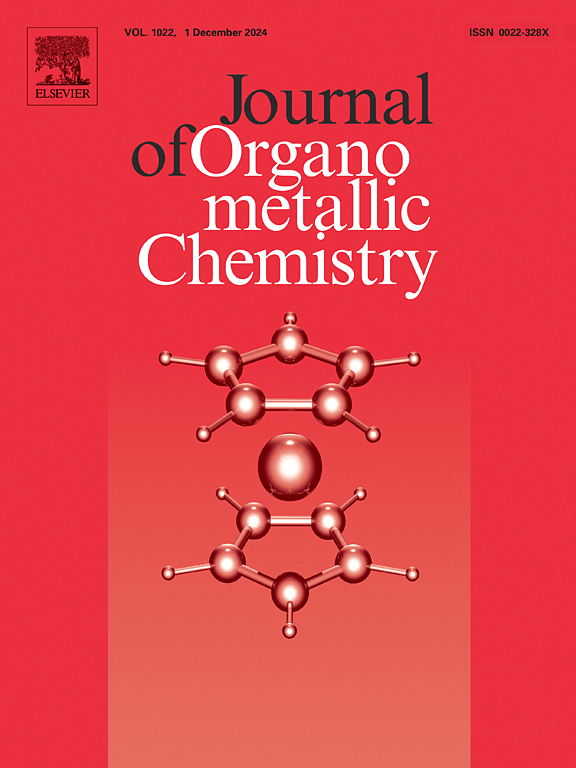钌(0)在σ-键活化中的应用:通过Ru-C键原位解理形成有机钌配合物并产生催化活性
IF 2.1
3区 化学
Q3 CHEMISTRY, INORGANIC & NUCLEAR
引用次数: 0
摘要
在本文中,我们报告了成功利用钌(0)对酚羟基进行芳基 CH 键活化,从而形成钌氢化和环钌化复合物的情况;以及这些复合物对选定底物的转移加氢反应(TH)的催化效率。在回流甲苯中,[Ru0(CO)3(PPh3)2]与 2-(芳基偶氮)苯酚(L-R;R = OCH3、CH3、H、Cl 和 NO2)反应会产生两种产物:通过活化酚 OH 键形成的 Ru 氢化物复合物(图示为 1-R);以及通过连续活化酚 OH 键和芳基 CH 键形成的环钌化复合物(图示为 2-R)。通过 DFT 计算探究了这两种复合物的形成机理,结果表明,Ru(0) 中心活化酚羟键的初始过程产生了 1-R。然后,1-R 通过吸收回流溶剂提供的热能转化为其几何异构体,配位羰基和氢化物的相互位置发生变化。最后,在配位氢化物的帮助下,芳基 CH 键活化,通过消除分子氢形成环钌化复合物 2-R。通过在回流丙酮和邻二甲苯中分别进行合成反应,还可以完全形成 1-R 或 2-R 复合物。通过 X 射线衍射法测定了 1-R 和 2-R 家族部分成员的晶体结构。研究发现,氢rido(1-R)配合物能以 2-丙醇为氢源,高效催化芳基/烷基醛和酮与相应醇的 TH 反应。通过 2-丙醇置换 1-R 中的一个 PPh3 而在原位生成的溶剂配位氢化物 (A) 被认为具有催化活性。环钌化的(2-R)配合物不含任何 Ru-H 分子,也能以相同的效率催化类似的 TH。通过电子光谱研究,我们发现 2-R 复合物通过 2-丙醇辅助裂解 Ru-C 键,在原位生成了具有相同催化活性的 Ru-hydrido 物种(A)。本文章由计算机程序翻译,如有差异,请以英文原文为准。

Utilization of ruthenium(0) for σ-bond activation: Formation of organoruthenium complexes and emergence of their catalytic activity via in situ Ru-C bond cleavage
In this paper we report the successful utilization of ruthenium(0) for phenolic O![]() H followed by aryl C
H followed by aryl C![]() H bond activations leading to the formation of ruthenium-hydrido and cycloruthenated complexes; and catalytic efficiency of these complexes towards transfer-hydrogenation (TH) of selected substrates. Reaction of [Ru0(CO)3(PPh3)2] with 2-(arylazo)phenol (L-R; R = OCH3, CH3, H, Cl and NO2) in refluxing toluene affords two products: a Ru-hydrido complex (depicted as 1-R) formed via activation of the phenolic O
H bond activations leading to the formation of ruthenium-hydrido and cycloruthenated complexes; and catalytic efficiency of these complexes towards transfer-hydrogenation (TH) of selected substrates. Reaction of [Ru0(CO)3(PPh3)2] with 2-(arylazo)phenol (L-R; R = OCH3, CH3, H, Cl and NO2) in refluxing toluene affords two products: a Ru-hydrido complex (depicted as 1-R) formed via activation of the phenolic O![]() H bond; and a cycloruthenated complex (depicted as 2-R) via successive phenolic O
H bond; and a cycloruthenated complex (depicted as 2-R) via successive phenolic O![]() H and aryl C
H and aryl C![]() H bond activations. The formation mechanism of the two types of complexes was probed with DFT calculations, which revealed that initial phenolic O
H bond activations. The formation mechanism of the two types of complexes was probed with DFT calculations, which revealed that initial phenolic O![]() H bond activation by Ru(0) center produces 1-R. Then 1-R converts, via absorption of thermal energy provided by the refluxing solvent, into its geometrical isomer with change in mutual disposition of the coordinated carbonyl and hydride. Finally, aryl C
H bond activation by Ru(0) center produces 1-R. Then 1-R converts, via absorption of thermal energy provided by the refluxing solvent, into its geometrical isomer with change in mutual disposition of the coordinated carbonyl and hydride. Finally, aryl C![]() H bond activation takes place, assisted by the coordinated hydride, to form the cycloruthenated complex 2-R via elimination of molecular hydrogen. Exclusive formation of 1-R or 2-R complexes could also be achieved by carrying out the synthetic reaction respectively in refluxing acetone and ortho-xylene. Crystal structures of selected members from both the 1-R and 2-R families have been determined by X-ray diffraction method. The hydrido (1-R) complexes were found to efficiently catalyze TH of aryl/alkyl aldehydes and ketones to the corresponding alcohols, using 2-propanol as the provider of hydrogen. A solvent coordinated hydrido species (A), generated in situ via displacement of a PPh3 from 1-R by 2-propanol, is believed to function as the catalytically active species. The cycloruthenated (2-R) complexes, which do not contain any Ru-H moiety in them, are also found to catalyze similar TH with equal efficiency. Through electronic spectral studies it has been realized that the same catalytically active Ru-hydrido species (A) is generated in situ from the 2-R complexes via 2-propanol assisted cleavage of the Ru-C bond.
H bond activation takes place, assisted by the coordinated hydride, to form the cycloruthenated complex 2-R via elimination of molecular hydrogen. Exclusive formation of 1-R or 2-R complexes could also be achieved by carrying out the synthetic reaction respectively in refluxing acetone and ortho-xylene. Crystal structures of selected members from both the 1-R and 2-R families have been determined by X-ray diffraction method. The hydrido (1-R) complexes were found to efficiently catalyze TH of aryl/alkyl aldehydes and ketones to the corresponding alcohols, using 2-propanol as the provider of hydrogen. A solvent coordinated hydrido species (A), generated in situ via displacement of a PPh3 from 1-R by 2-propanol, is believed to function as the catalytically active species. The cycloruthenated (2-R) complexes, which do not contain any Ru-H moiety in them, are also found to catalyze similar TH with equal efficiency. Through electronic spectral studies it has been realized that the same catalytically active Ru-hydrido species (A) is generated in situ from the 2-R complexes via 2-propanol assisted cleavage of the Ru-C bond.
求助全文
通过发布文献求助,成功后即可免费获取论文全文。
去求助
来源期刊

Journal of Organometallic Chemistry
化学-无机化学与核化学
CiteScore
4.40
自引率
8.70%
发文量
221
审稿时长
36 days
期刊介绍:
The Journal of Organometallic Chemistry targets original papers dealing with theoretical aspects, structural chemistry, synthesis, physical and chemical properties (including reaction mechanisms), and practical applications of organometallic compounds.
Organometallic compounds are defined as compounds that contain metal - carbon bonds. The term metal includes all alkali and alkaline earth metals, all transition metals and the lanthanides and actinides in the Periodic Table. Metalloids including the elements in Group 13 and the heavier members of the Groups 14 - 16 are also included. The term chemistry includes syntheses, characterizations and reaction chemistry of all such compounds. Research reports based on use of organometallic complexes in bioorganometallic chemistry, medicine, material sciences, homogeneous catalysis and energy conversion are also welcome.
The scope of the journal has been enlarged to encompass important research on organometallic complexes in bioorganometallic chemistry and material sciences, and of heavier main group elements in organometallic chemistry. The journal also publishes review articles, short communications and notes.
 求助内容:
求助内容: 应助结果提醒方式:
应助结果提醒方式:


